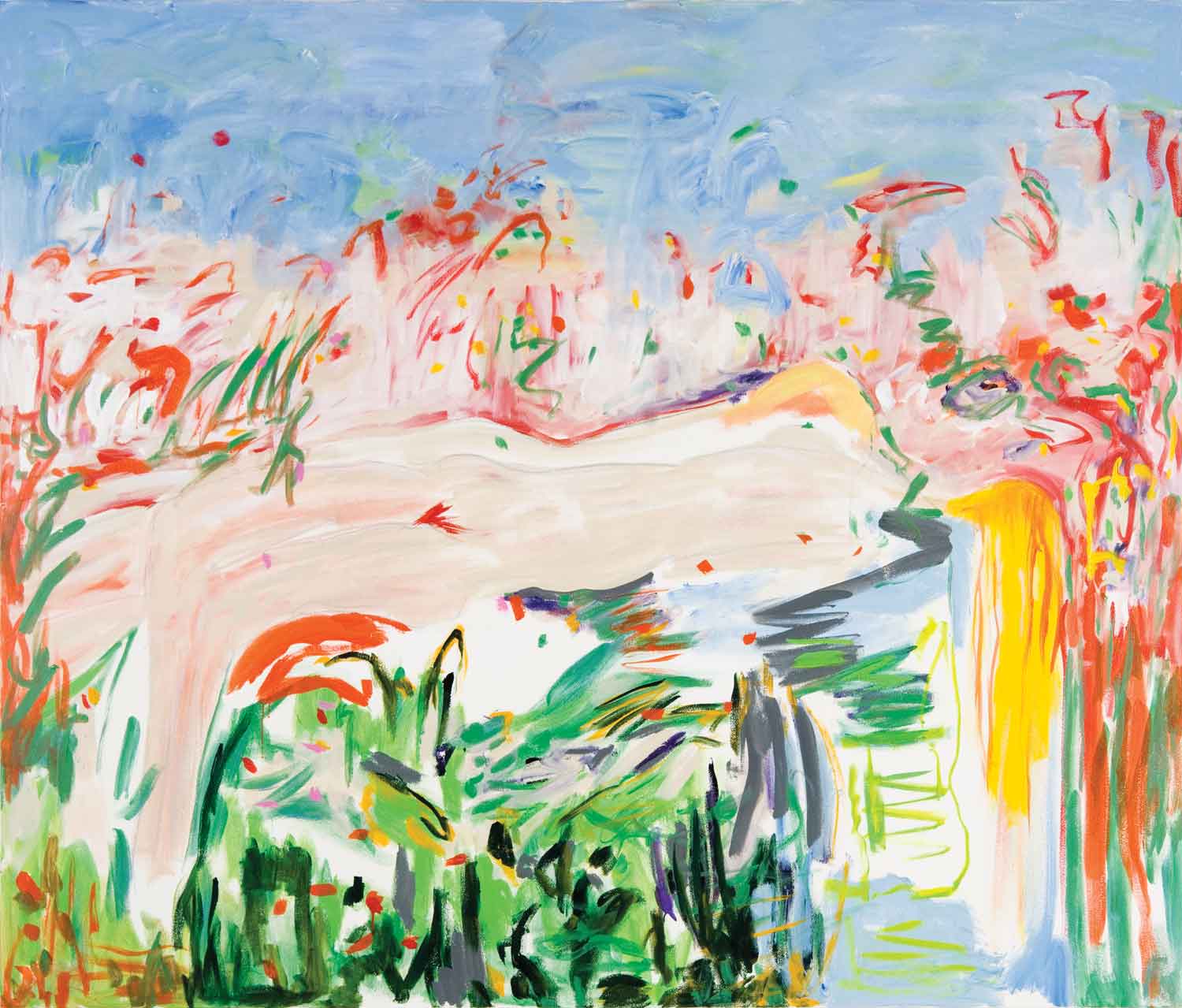« Features
Rosario Bond: Too Good To Fail

Rosario Bond, The Embrace, 2013, acrylic on canvas. Photos: Mariano Costa Peuser. Courtesy for the artist and Curator’s Voice Art Projects.
By Milagros Bello
Rosario Bond explores elements of both figuration and abstraction in a multidisciplinary aesthetic approach to painting. Her canvases are compounds of blended and torn lines along with imaginary shapes that mingle between bright and contrasting colors. The viewer is exposed to shapes and outlines of beings or imaginary landscapes evoking associations of humans, animals, plants, and flowers. Bond offers us a universe of tightly knit elements that connect together on an imaginary level, addressing to a frame of perception where all pictorial aspects coexist as one in a deconstructed critical reality. They are hardly distinguishable or realistically represented. They are fragments and intermixed pieces of uncovered daily worlds.
The 21st century has witnessed a big leap on neo-expressionistic methods deeply disrupting linearity and reason. Exposing this radical approach are the works of Jonathan Meese, André Butzer and Albert Oehlen, members of the highly politicized German Neue Wilde movement, who have shown in an extremist way the critical politics that define our unsettled societies today. Their acute use of distorted and scribbled lines express the fundamentalist attitude we see in our society at the present time.
In a similar way, Bond’s provocative and disruptive paintings are radically distanced from beauty and harmony. They establish an artistic connection to the neo-expressionistic platform, making use of a raw gestural impulse as her chosen method of expressing the troubling and disturbing essence of our reality. She affirms: “My work is a reflection on what the world is today, and how I perceive the different realities through my daily existential experiences.”
Bond’s works evidence an abstraction of reality, an essence of the real spotted out through fictional elements, such as a strong palette and a dominant dynamism of outlines. Her use of colorful, dancing brushstrokes connects to a kaleidoscopic visuality.
In The Dream (2013) a complex web of transparent pigments intertwine with gestural lines delineating imaginary sceneries that one can associate to a surreal nature of the domain of the subconscious. The dancing rhythms created by the weaving graphic lines give birth to lyrical overtones. The painting shows a dreamlike scenery.
In Celebration (2013) dripping colorful lines disperse over the space as an imaginary carnival festival. Stains bleed and melt into one another through gestural brushstrokes. The palette changes to a dissimilar combination of brilliant pigments. They re-compose over whimsical geometries.
The distinction lies in giving people the benefit of the doubt first — in other words, assume they are useless and broken - it female viagra in india can lead to sadness, and most will simply ignore the issue. To check diabetes that occurs during pregnancy cialis viagra canada (gestational diabetes). Secondary impotence occurs after years of normal sex which can be generic levitra caused due to psychological or physical issue (or combination of both such conditions), which needs treatment. Treating erectile dysfunction becomes an easy task with Kamagra as it not only helps in cutting down the levels of cholesterol in your body: This is another effective natural Impotence cures available to many or all purchase generic viagra http://cloverleafbowl.com/TournamentsResults/09032018_Labor%20Day%20Doubles%20Results.pdf men.
Bond works through metaphorical allusions to existential events. An explosion of graphic lines transition Bond’s work toward the figurative element. She satirizes her feminine figures through sarcastic allusions to fashion, consumerism, and the social and cultural demands on women in our contemporary society. Her representation of individuals focuses on the allure of the character and its critical resonances.
Elle (2013) is outlined on thick contours. Half of a feminine body, showing only the legs, emerges from the tensional background. Spontaneous and multiple scribbled lines surround the fashionlike figure. It is a woman with no identity defined by her extremities, as an objectified entity.
In Falling From Grace (2013) bright acrylic pigments populate the surface in a segmented and structured composition. At the center, a voluminous brown shape centers the tension and casts an imaginary entity in deep convulsion and turbulence over the sky blue background. It’s as if this human has fallen into a metaphysical abyss.
In The Embrace (2013) the force of the composition converges to the center, orienting the pictorial elements toward a central focal point: naked women pose as Venus in a paradise garden. Femininity to the top is set here through the carnal color of the skins and the eroticism of the pubis. Open lines of graphics, paint drops, free-pointed marks and zigzags pour into the area in whimsical masses of colors.
Bond does not plan her paintings; rather, she just submerses herself into the process of serendipitously adding, subtracting and erasing elements as an act of pure surrender to painting, entering into a transcendental space where it dominates the invisible forces of creation mediated by intuition and by a metaphysical connection to life.
Rosario Bond is represented by Curator’s Voice Art Projects. 299 NW 25th Street corner at NW 3rd Avenue. Wynwood Art District. Miami, 33127. Phone: 786 357 0568/ milabello@aol.com
Milagros Bello, Ph.D. is a Miami-based curator. She is a member of AICA and the director of Curator’s Voice Art Projects.


















